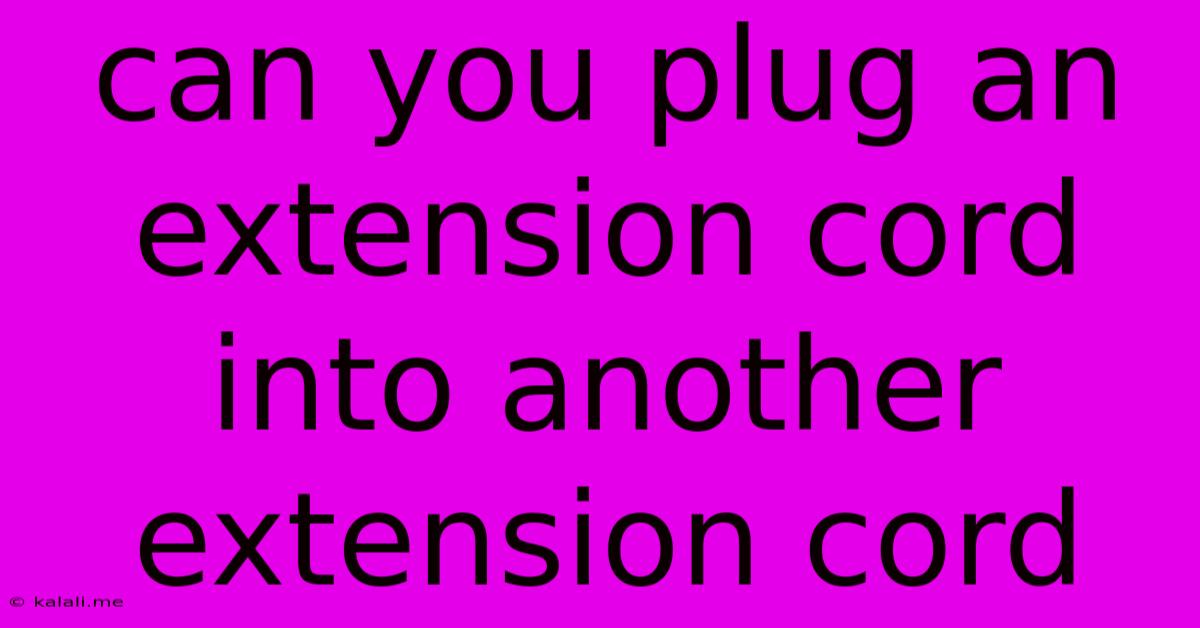Can You Plug An Extension Cord Into Another Extension Cord
Kalali
May 19, 2025 · 3 min read

Table of Contents
Can You Plug an Extension Cord into Another Extension Cord? A Comprehensive Guide to Extension Cord Safety
Plugging one extension cord into another might seem like a simple solution when you need extra reach for your appliances. However, this seemingly innocuous practice can pose significant safety risks if not done correctly. This article will delve into the best practices, potential dangers, and everything you need to know about daisy-chaining extension cords.
Understanding the Risks of Daisy-Chaining Extension Cords
The biggest danger lies in overloading the circuit. Each extension cord has a maximum amperage rating, indicated on its label. When you connect multiple extension cords, the current flows through each one, cumulatively increasing the load on the original outlet and each cord in the chain. Exceeding the amperage rating can lead to:
- Overheating: Excessive current flow generates heat, potentially melting the insulation and causing a fire. This risk is amplified with cheap, low-quality extension cords.
- Electrical shock: Damaged insulation due to overheating can expose live wires, increasing the risk of electric shock.
- Tripped breaker or blown fuse: The circuit breaker or fuse in your electrical panel will act as a safety mechanism and trip or blow, cutting off power to the entire circuit. While this is a safety feature, it's inconvenient and indicates a potential overload.
When Daisy-Chaining Might Be Acceptable (With Cautions)
While generally discouraged, there are very specific situations where daisy-chaining might be acceptable:
- Low-wattage appliances: If you're connecting only low-power devices like lamps or small electronics, the cumulative amperage draw might remain within the safe limits of the extension cords. Always check the amperage rating of each cord and the total wattage of connected devices to ensure you stay well below the limit.
- Short distances and high-quality cords: Using heavy-duty, high-gauge extension cords (lower gauge numbers indicate thicker wires and higher amperage capacity) for short distances minimizes voltage drop and reduces the risk of overheating.
Best Practices for Safe Extension Cord Usage
Instead of daisy-chaining, consider these safer alternatives:
- Use a power strip: Power strips offer multiple outlets from a single plug, eliminating the need to chain cords.
- Run a longer cord directly to the appliance: Choose an extension cord long enough to reach the appliance without needing to connect multiple cords.
- Consider a surge protector: A surge protector will safeguard your devices from power surges and voltage spikes.
- Inspect your cords regularly: Check for damaged insulation, frayed wires, or loose plugs. Discard any damaged cords immediately.
- Use the correct gauge cord for the wattage: Higher-wattage appliances require heavier-duty extension cords with lower gauge numbers.
Conclusion: Prioritize Safety
While the convenience of plugging an extension cord into another might be tempting, the inherent safety risks should not be ignored. Understanding the potential dangers and following the best practices outlined above will help you avoid accidents and ensure the safety of your home and devices. Always prioritize safety over convenience when working with electricity. When in doubt, consult a qualified electrician.
Latest Posts
Latest Posts
-
Substitute For Crushed Red Pepper Flakes
May 20, 2025
-
Using Work Phone As Personal Phone
May 20, 2025
-
Train From El Prat To Sitges
May 20, 2025
-
Is Toothpaste A Liquid Or A Solid
May 20, 2025
-
A Form Of Leather That Was Popularised By Native Americans
May 20, 2025
Related Post
Thank you for visiting our website which covers about Can You Plug An Extension Cord Into Another Extension Cord . We hope the information provided has been useful to you. Feel free to contact us if you have any questions or need further assistance. See you next time and don't miss to bookmark.